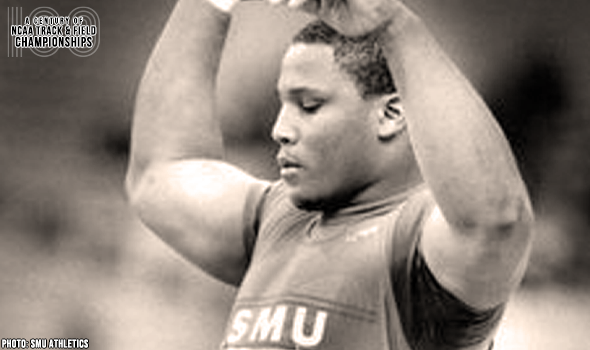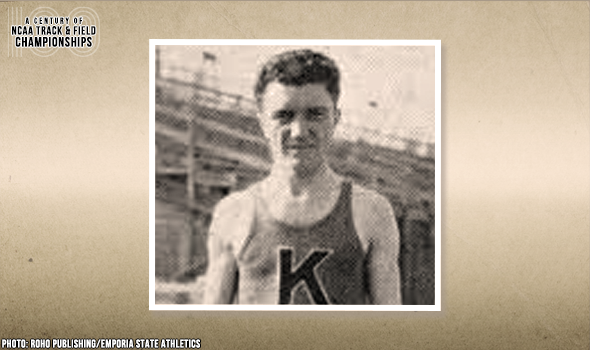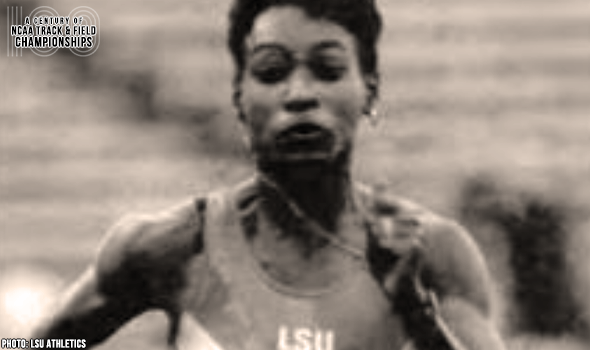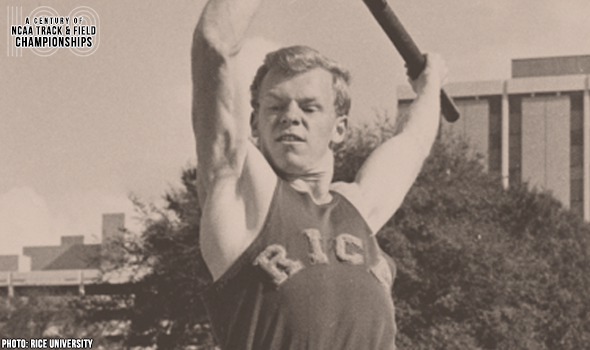
Carter’s Shot Put Prowess Was Legendary
In January 1983, Michael Carter of SMU picked up a shot for the first time in 18 months.
By June of that same year, he was looking to regain the national title in that event at the NCAA Division I Outdoor Track & Field Championships in Houston.
Carter – who had won in 1980 and 1981 – wasn’t able to try for a third in 1982 when he missed the entire indoor and outdoor seasons recovering from a football injury he suffered in October 1981. He was the starting nose tackle for the Mustangs, who were undefeated in 1982 and only lost one game in 1981.
After the cast on Carter’s right knee came off in January 1982, Carter showed his competitive side, telling John Eisenberg of the Dallas Times-Herald: “As soon as I get the go-ahead, I’m going to bust my butt like I never did before. I’m going to make my legs stronger than they ever have been.”
Meanwhile, another strong throwing figure emerged in 1982 with Carter’s absence – Oregon’s Dean Crouser, who not only won the NCAA shot that year but the discus as well. And the day before the 1983 NCAA shot final, Crouser looked great, repeating his discus win with a meet-record 65.88m (216-2) while Carter was 10th (Carter placed runner-up two years earlier in 1981).
Carter made this shot final his from the beginning. He took the immediate lead with a 20.22m (66-4¼) effort in Round 1 and then followed with the winning have of 20.90m (68-7) – his best since a pre-injury 21.25m (69-8¾) that set an NCAA Indoor meet record in 1981. Crouser, the defending champion, finished third behind John Brenner of UCLA.
As it turns out, Carter’s points were crucial to SMU, which eked out a two-point victory over Tennessee to complete a sweep of indoor and outdoor team crowns.
“I knew in the back of my mind that Crouser could hit a big one at any time,” Carter said after the meet. “I tried to improve after the second throw, but I couldn’t. I wanted to keep my string alive; my goal is eight straight.”
At this point, Carter had six national titles in the shot put – three each indoor and outdoor. He got to seven with his indoor victory in 1984, but his attempt for eight was part of an epic duel with Brenner that will be the subject of its own forthcoming moment in this series.
Alas for track & field fans, Carter’s last shot put competition came when he earned the silver medal at the Los Angeles Olympics. He then joined the NFL’s San Francisco 49ers, with whom he was part of three Super Bowl champion teams.
Michael’s two daughters also won NCAA titles – Michelle (Texas), the 2006 indoor shot put champion; D’Andra (Texas Tech), the 2009 discus champion – making the Carters the first family with three NCAA Division I track & field champions. In 2016, Michelle earned the family’s first Olympic gold medal, also becoming the first American woman to win the shot put.
The NCAA and collegiate track & field will mark a momentous milestone in the spring of 2021 -- the 100th anniversary of the NCAA Championships and with that, the NCAA Track & Field Championships. In June 1921, the University of Chicago hosted the first track & field championships in NCAA history.
This point can’t be emphasized enough: Not only was the event the first for NCAA track & field, but the first championships for any sport under the sponsorship of the NCAA.
To celebrate, over each of the next 365 days, the U.S. Track & Field and Cross Country Coaches Association (USTFCCCA) will celebrate moments, student-athletes, and coaches that have made a century’s worth of championships special. From humble beginnings to important historical milestones to the modern-day, collegiate track & field has evolved with the American society.
The 2021 edition of the NCAA Division I Outdoor Track & Field Championships begin with preliminary round action on May 27-29 in Jacksonville, Fla., and College Station, Texas. The championships final site and culmination of the celebration is slated for June 9-12, 2021 at the newly rebuilt Hayward Field in Eugene, Ore.

Clemson’s Ross Kept Getting Faster In 1995
Duane Ross PR’d twice in the 110H at the 1995 NCAA DI Outdoor T&F Championships. When Ross won in 13.32, he became the No. 3 performer in collegiate history.

Illinois’ Kerr Went Back-To-Back At NCAAs
George Kerr won back-to-back 800/880 titles at the NCAA Outdoor T&F Championships in 1959 & 1960. Kerr set a meet record of 1:46.4 in the 800 meters in 1960.

UCLA’s Baucham Bounded To TJ CR In 2005
Candice Baucham won the triple jump at the 2005 NCAA DI Outdoor T&F Championships with a collegiate record of 14.07m (46-2). Baucham took the event by more than one foot.

San Romani Went From Unknown To Legend
Archie San Romani won back-to-back 1500/mile crowns at the NCAA Outdoor T&F Championships in 1935 & 1936.

Auburn’s Glance Made Them Look Twice
Harvey Glance completed the 100-200 double as a freshman at the 1976 NCAA DI Outdoor T&F Championships. He set a meet record of 10.16 in the 100.

Nova’s Rhines Did NCAA 5K Three-Peat
Jen Rhines was the first female athlete in the history of the NCAA DI Outdoor T&F Championships to win three consecutive 5K titles.

Georgia’s Erm Cruised To 2019 Decathlon Title
Johannes Erm won the decathlon at the 2019 NCAA DI Outdoor T&F Championships by 342 points with his 8352 total. That was also the fifth-best score in meet history.

McMillen Adapted, Set 1500 MR In 1952
Bob McMillen set a meet record in the 1500 meters of 3:50.7 at the 1952 NCAA Outdoor Track & Field Championships.

LSU’s Duhaney Destroyed NCAA 200 Field In 1992
Dahlia Duhaney owns the largest margin of victory in meet history in the 200 with her 0.44-second winner at the 1992 NCAA DI Outdoor T&F Championships.

Rice’s Roberts Cooked Up Pole Vault Greatness
Dave Roberts was the second man to win three consecutive pole vault titles at the NCAA DI Outdoor T&F Championships, doing so from 1971 to 1973.

